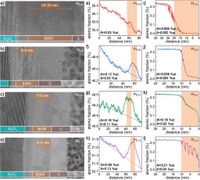In a groundbreaking study, researchers have successfully alloyed hexagonal boron nitride (hBN) with aluminum, achieving a significant modulation of the material's electronic properties. This innovative approach opens new avenues for developing more efficient optoelectronic devices capable of operating in the challenging deep ultraviolet (DUV) spectral range, ranging from 200–280 nm. The findings, published on March 22, 2025, push the boundaries of existing knowledge about 2D materials and hold promise for crucial applications in disinfection and sterilization technologies.
Hexagonal boron nitride has been recognized for its intrinsic properties that make it an attractive material for various technological applications. Known for its strong sp2-bonded crystal structure, researchers have conducted extensive studies on how to manipulate its characteristics to enhance performance in optoelectronic devices. This new research takes a step further by introducing aluminum into the hBN structure, yielding aluminum alloyed hBN (hBAlN) samples grown through metal organic vapor phase epitaxy on 2-inch sapphire substrates.
The significance of this study lies not only in the successful alloying process but in the revelations of the optical properties of the resulting hBAlN layers. Optical absorption measurements revealed two prominent peaks within the excitonic spectral range, with absorption coefficients measuring approximately 106 cm-1. The peak energies observed were closely aligned with the energies of indirect (5.955 eV) and direct (6.125 eV) bandgap transitions in hBN, indicating a profound alteration in the electronic states due to aluminum incorporation.
Explaining this phenomenon, the authors of the article stated, "The observed effects offer insights into hBN-based two-dimensional alloys, highlighting the potential for developing 2D material-based quantum well structures capable of operating in the challenging deep UV spectral range." Moreover, a unique low-energy peak corresponding to indirect excitonic transitions was identified, which had not been observed in previous studies, signifying the intricate interplay of electronic states within the material.
To achieve these results, researchers meticulously controlled the aluminum concentration across samples, noting values ranging from 0.01% to 1.1%, with an aluminum incorporation rate of approximately 3%. Techniques used in the study included high-resolution transmission electron microscopy, X-ray diffraction, and Fourier-transform infrared spectroscopy, all confirming the maintenance of the sp2-bonded structure characteristic of hBN after alloying.
In their conclusions, the researchers highlight the potential applications of hBAlN layers in future devices, particularly in enhancing the efficiency of DUV light sources, which currently operate at low efficacy—around 10% for wavelengths of 270–280 nm and about 3% for 250 nm.
Advances in this area are critically important, as these spectral ranges are not only essential for industrial lighting solutions but also hold significant promise for public health applications, such as sterilization of air and water. However, further exploration is needed to fully understand the alteration of the hBN bandgap energy as a result of aluminum alloying—knowledge deemed essential for designing hBN-based quantum wells that would effectively facilitate efficient emission from the structures.
While battling challenges associated with achieving consistent and high-quality alloys, the researchers remain optimistic about the prospects of their findings. As they remarked, "We conclude that since we do not have a perfect hexagonal phase, the main reason for the XRD peak position change in our samples is that it is attributed to random twists of subsequent atomic layers." This insightful observation emphasizes the complexity underlying the structure of the modified hBN.
In conclusion, the research presents a bold new direction for exploring and tuning the properties of 2D materials through alloying, paving the way for potentially significant advancements in optoelectronic technologies aimed at tackling modern challenges—especially in the realm of public health.




